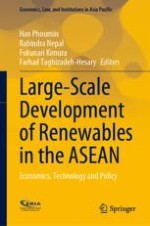This book combines the fundamentals of economics, technology, and policy in deriving feasible solutions to facilitate the large-scale development of renewables in the ASEAN. A unique feature of this book is documenting that achieving large-scale renewables deployment inevitably requires combining these three distinct but interrelated forces of economics, technology, and policy. The economic foundations are guided by the microeconomic foundations grounded on economic efficiency and the associated market designs to deliver short-run economic efficiency including the application of auction designs and cost-benefit analysis. The role of battery technology and utility-scale batteries as enabling technologies for large-scale deployment of renewable energy is evidenced through energy modeling techniques. This book also pays particular emphasis on identifying key policy barriers of large-scale renewable development and pathways to overcome them such as the importance of carbon pricing in ASEAN countries and cross-border electricity trade to improve energy security by achieving clean energy targets. Country-specific case studies and regional case studies are used to study the economic, technological, and policy facets of large-scale renewable development with a view to derive policy lessons and recommendations in decarbonizing economic regions such as the ASEAN. The case studies are carefully selected and supported by rigorous data analysis and modeling as appropriate. This book on energy economics and policy is highly recommended to readers who seek an in-depth and robust overview on the recent empirical evidences of facilitating the large-scale development of renewables with a particular reference to the ASEAN and Asian economies including India and China.
